The 12th Defense Battalion of World War IIThanks to the Internet, I've been able to do some research that has revealed details about my dad's experiences during World War II. Dad was a proud Marine--a veteran of war who suffered and survived the bitter fighting in the South Pacific for nearly three years. As you read this account, please take note of the sacrifices these men made for our freedom. When they weren't engaged in intense battles, they lived in pup tents; when aboard the ships, they were often seasick; in the jungles, they fought tropical diseases; otherwise, they fought boredom, and there weren't even any nearby towns where they could spend a weekend furlough.I have tried to present the information chronologically. My sources include my personal interviews with Dad, as well as Internet articles and photographs. My Internet sources are listed at the bottom, where you can read more details. From Enlistment to Woodlark IslandMy dad, Clarence O. Weber, enlisted in the Marine Corps on August 8th, 1942. He left immediately for Boot Camp, traveling by train to San Diego, CA. In January, 1943, Colonel William H. Harrison activated the 12th Defense Battalion ("the 12th"), and Dad was among the 1500 men in this battalion. They left immediately for Hawaii, arriving on the island of Oahu, and they spent three months in Hawaii, including some time at Pearl Harbor. In May, 1943, they left Hawaii and traveled to the Samoan Islands, then on to Australia, arriving at Townsville. In June, 1943 they traveled to New Guinea, then to Woodlark Island northeast of New Guinea.Woodlark Island - First CombatIt was on Woodlark Island where Dad got his first taste of combat, serving as a Director on a 90-millimeter anti-aircraft artillery crew. The 12th Defense Battalion suffered heavy bombing from the Japanese as they covered the occupation of Woodlark Island. They defended Army ground units while Army engineers and Navy Sea Bees built an airfield in just 16 days. The airfield was completed on June 30th, 1943, and the 12th Defense Battalion protected it until the end of the year. The main purpose of the Woodlark operation was to screen the landings on New Georgia in the central Solomon Islands.The Solomon IslandsOn November 1st, 1943, the U.S. offensive reached the northern Solomon Islands, and the 3rd Marine Division landed at Bougainville. The 3rd Defense Battalion followed the first waves ashore, having heavy machine guns and light anti-aircraft guns ready for action by nightfall. The battalion organized both anti-aircraft defenses and beach defenses, taking advantage of the dual capabilities of the 90-mm gun to destroy Japanese landing barges on the Laruma River. The 155-mm artillery group joined the 12th Defense Battalion Marines, the 3rd Marine Division's artillery regiment in shelling Japanese positions at Torokina. Some members of the 12th Defense Battalion remained at Bougainville into 1944, earning the dubious honor of being "the last Fleet Marine Force ground unit" to be withdrawn from the Solomon Islands.- Photo # 1: The photograph below was taken at the Solomon Islands, and it shows the 90-millimeter anti-aircraft cannon along with its five-man crew. As a Corporal, Dad served as Director on one such crew, and it's not entirely impossible that he's even in this photo. 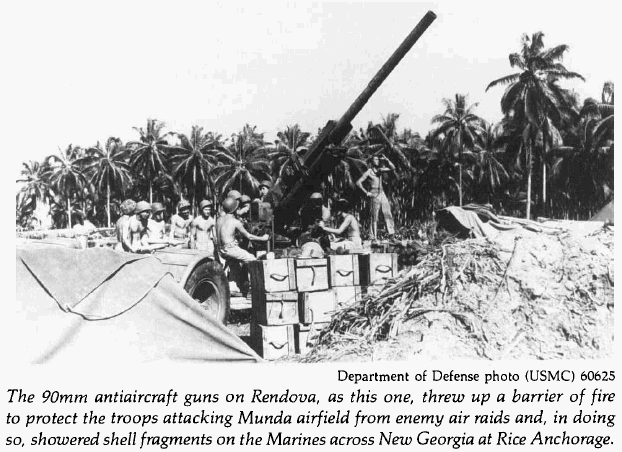 New BritainThe 12th Defense Battalion supported the landing of the 1st Marine Division in the assault on Cape Gloucester, New Britain, in December, 1943. The lodgment on New Britain marked the end of the Rabaul campaign (and of participation by major Marine Corps units in the South Pacific), as the United States had decided to isolate and bypass the fortress instead of storming it. Radar operator Victor C. Bond, a member of the 12th Defense Battalion at Cape Gloucester, remembered sitting on the exposed "plow seat" of an SCR-268, with 90-mm guns firing nearby. "During an air raid," he said, "it was difficult to tell if all the noise and smoke was due to the 90-mms or the enemy."- Photo # 2: The photograph below was taken on New Britain Island, and it shows the actual fire from the 12th Defense Battalion as the anti-aircraft artillery attacked incoming Japanese planes. I once asked Dad if they ever hit any Japanese planes, and he explained that there was so much fire in both directions, that when Japanese planes fell, it was impossible to tell which artillery hit it. From looking at this photo, it's easy to see what he meant. 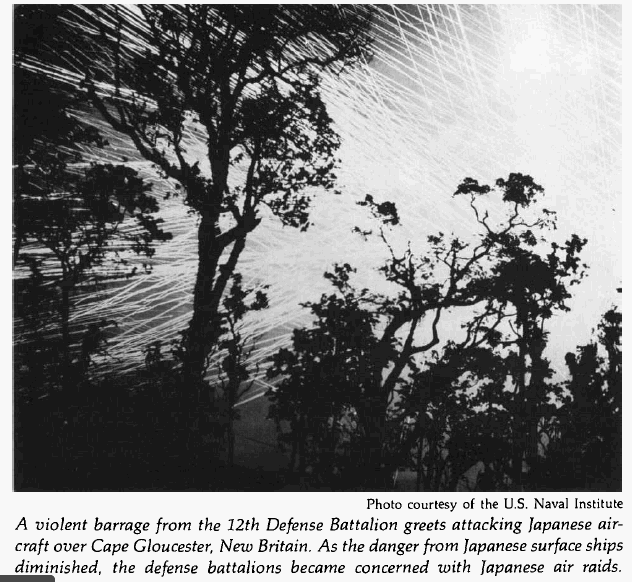 - Photo # 3: The photograph below shows the 12th Defense Battalion aboard an LST (Landing Ship, Tank) on the approach to storm the beaches at Cape Gloucester, New Britain. Dad occasionally talked about these LSTs, and it's not such a long shot that he could actually be in this photo, which might include 100 to 200 Marines from the 12th Defense Battalion. 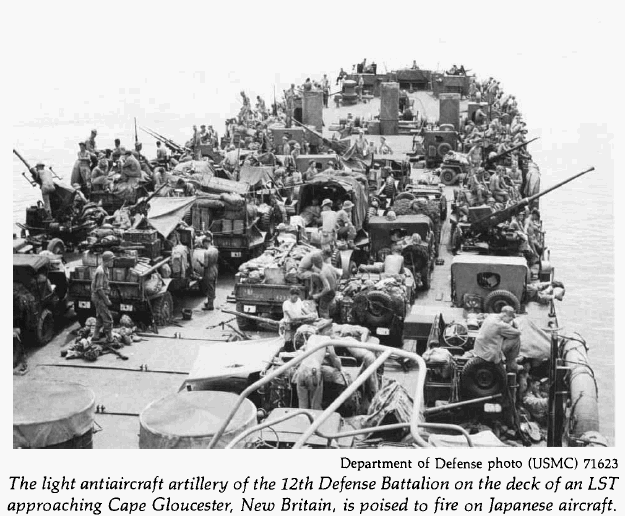 On New Britain, the 12th Defense Battalion suffered most of its casualties from typhus and other diseases, falling trees, and lightning. "There is no jungle in the world worse than in southwestern New Britain," said a member of the 1st Marine Division. Malaria was prevalent in the swamps and rain forest, and the effort to limit its effects included the use of atabrine, a substitute for scarce quinine. This remedy required hard selling by medical personnel and commanders to convince dubious Marines to take a bitter-tasting medicine that was rumored to turn skin yellow and make users sterile. In a light-hearted moment, Second Lieutenant Gerald A. Waindel suggested adapting a slogan used to sell coffee back in the United States: "Atabrine--Good to the last drop." - Photo # 4: The photograph below shows a Marine finding an uncomfortable place to rest. This could also be Dad in this photo. This lifestyle must have been maddening. One day you're scared to death and in a battle for your life and the lives of your fellow Marines; the next day you're bored, with no towns to visit; the next day you board a ship for three months, and you find yourself vomiting over the side most of the time. 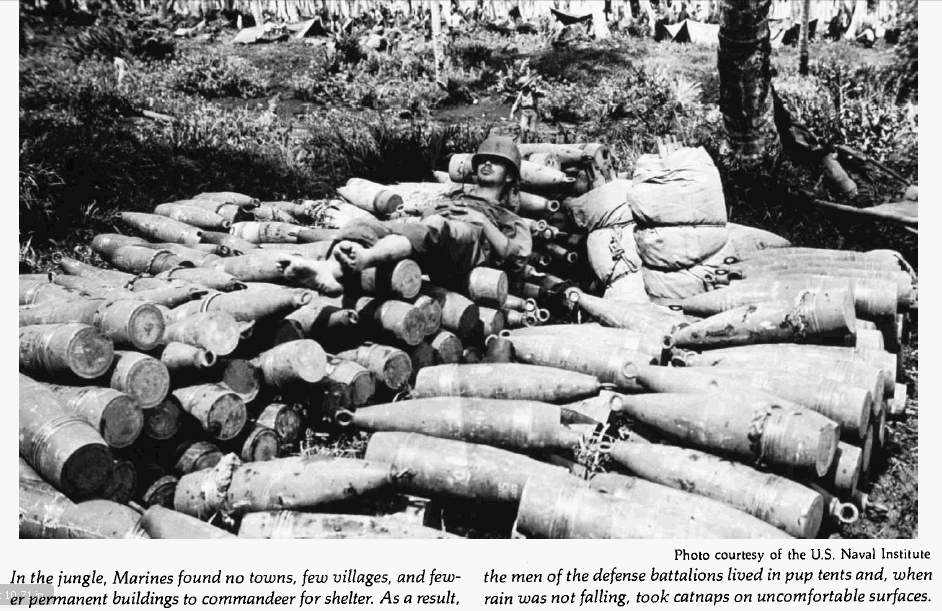 The 12th Defense Battalion moved back to New Guinea, where they spent Christmas of 1943. While the Central Pacific campaign moved through the Gilberts, Marshalls, and Marianas, the 1st Marine Division prepared to seize Peleliu in the Palau Islands to protect MacArthur's flank as he re-entered the Philippines. Dad was on Peleliu with E. B. Sledge, author of With the Old Breed.
The division landed on September
15th, 1944, triggering a bloody battle that tied down most of the
division until mid-October. Army troops didn't defeat the
last organized Japanese resistance until the end of November. PeleliuIn September, 1944, the 12th Defense Battalion moved to Peleliu, where they endured some of the most heated fighting of World War II. During the bitter fighting on Peleliu, the 12th Defense Battalion supported the 1st Marine division while it fought to conquer the island. The infantry of the 1st Marine Division and others, and the anti-aircraft defense of the 12th Defense Battalion combined to provide a slow but decisive victory for the U.S. Peleliu has been described as "the most heavily fortified ground, square yard by square yard, Marines have ever assaulted." The Marine anti-aircraft gunners at Peleliu dug in on what was described as "an abrupt spine of jagged ridges and cliffs - jutting dragon-tooth crags, bare and black, where Marine infantrymen fought maniacal Japs."It was this victory by the Marines at Peleliu that enabled General Douglas MacArthur to be able to keep his promise of returning to the nearby Philippine Islands. As the fury of the fighting abated, the 7th Battalion transferred personnel and equipment to the 12th Defense Battalion, which (according to logistics officer, Harry M. Parke) received newer material and "men with less time overseas," who would not become eligible to return home when the units began preparing for the invasion of Japan. By the end of 1944, with Peleliu and the Marianas firmly in American hands, 74,474 Marines and sailors served in island garrisons and base defense forces. As the defense battalion program focused on antiaircraft weapons, defense units--most of them by now re-designated as anti-aircraft artillery outfits--served in the Southwest Pacific, including battalions stationed at Guadalcanal (the 3d and 4th with III Amphibious Corps), and the Russell Islands (the 12th Defense Battalion with III Amphibious Corps). In the early part of 1945, the 12th Defense Battalion moved from Peleliu to Okinawa, and then on to Guam. MacArthur advanced from the Southwest Pacific through the Philippines, and Nimitz's controlled the Central Pacific. The goal of these two campaigns was the ultimate invasion of the Japanese Home islands. As the Marines continued bitter fighting at Iwo Jima and Okinawa in the early part of 1945, Japanese air attacks attained unprecedented savagery in the waters off Okinawa. Japan's Special Attack Corps pressed home the suicidal kamikaze attacks first employed in the Philippines. (They engaged much like the original Kamikaze, or divine wind, of the 16th century, that successfully scattered a Mongol invasion fleet.) Hoping to save Japan, the suicide pilots deliberately dived into American ships, with the hope of trading one life for hundreds. Japan also used other vehicles for suicide attack, including piloted bombs, manned torpedoes, and explosive-laden motorboats. However, even these desperate measures could not prevail, and the United States seized the essential base at Okinawa for the planned invasion of Japan. In mid-1945, the 12th Defense Battalion returned to Pearl Harbor in Hawaii, and then set out for the U.S. Mainland, thinking that they were returning to the U.S. only for a short rest and a well-deserved furlough. It was during this leg of their journey that Marines on Tinian in the Marianas witnessed the takeoff on 6 August 1945 of the B-29 Enola Gay, which dropped an atomic bomb on Hiroshima. Three days later, another B-29 also from Tinian's North Field, dropped a second atomic bomb on Nagasaki. Japan found itself facing many insurmountable challenges, including: the shock of the atomic weapons; the entry of the Soviet Union into the war in the Pacific; the cumulative effects of attrition throughout the vast Pacific; months of conventional bombing of the Home Islands; and, an ever-tightening submarine blockade. The formal cessation of hostilities finally ended on August 15th, 1945, when the Empire of Japan formally surrendered to General MacArthur aboard the USS Missouri in Tokyo Bay. Members of the 8th Anti-aircraft Artillery Battalion on Okinawa tracked the last air attack of the war--a raid that turned back short of the target when the Japanese government surrendered. The gloomy outlook during the early days in the South Pacific had been encapsulated in the slogan, "Golden Gate in '48"--suggesting that the fighting might continue until 1948. However, this suddenly gave way to a new slogan, "Home Alive in '45." The actual homecoming would be delayed, however, for those Marines scheduled for occupation duty in Japan or North China. However, the 12th Defense Battalion Marines returned to San Diego on August 20, 1945, after 31 months overseas. Dad soon traveled by train to the state of Virginia, where he received his Honorable Discharge from the United States Marine Corps on November 27, 1945, at age 24, after 39 months of faithful service to his country as a veteran of war. - Photos # 5 and # 6: The photographs below show eleven survivors of the 12th Defense Battalion at their 56th reunion in 2009. Their reunion took place aboard the ship that was named after the bloodiest battle that they were a part of--The Peleliu. Dad attended several of these reunions during the late 80s and early 90s, and it is likely that he knew some of these 11 men during the war. 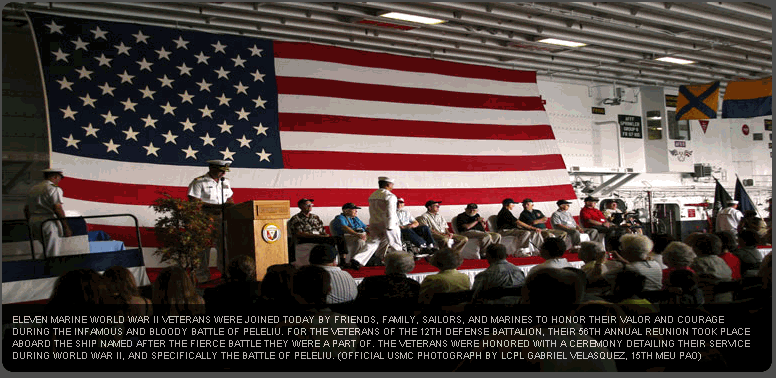 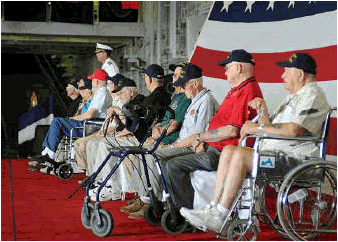 Tributes to the Defense BattalionsIn 1944, Master Technical Sergeant Alvin M. Josephy, Jr., a Marine combat correspondent wrote, "... since the beginning of the war many of the men ... had seen action in units smaller than divisions--in defense and raider battalions and other special commands. These Marines had been fighting for a long time."Leatherneck, a Marine magazine, noted in September 1944 that the complete story of each defense battalion would not be told until the war was won. Because of the crucial part they played, "much information about them ... must be withheld, but there are no American troops with longer combat records in this war." Defense battalions deployed early and often in distant and dangerous places throughout the Pacific campaigns. They were so far away from civilization that they could not even benefit from post-battle furloughs because there was no place to go for rest. The Marines of the defense battalions endured isolation, sickness, monotonous food, and primitive living conditions for long periods, as they engaged in the onerous task of protecting advance bases in areas that hardly resembled tropical paradises. Throughout their existence, the defense battalions demonstrated a fundamental lesson of the Pacific War--the need for teamwork. As one Marine Corps officer pointed out, the Marine Corps portion of the victorious American team was "itself the embodiment of unification." The Corps had "molded itself into the team concept without the slightest difficulty ... Marine tank men, artillery men, and anti-aircraft gunners of the defense battalions, interested only in doing a good job, gave equal support to ... [the] Army and Navy ..." The role of the defense battalions in the Pacific was defined by their relationships with other combat units, because they functioned as a part of a combined effort at sea, in the air, and on the ground. Finally, especially after the transition to anti-aircraft artillery battalions, the units tended to perform base-defense or garrison duty under the Fleet Marine Force, Pacific. The shift of the defense battalions from fighting front to backwater of the war reflected the changing strategic reality of the war in the Pacific--not an arbitrary decision to de-emphasize their role. Some of the Marines in these units may have felt that the spotlight of publicity passed them by and focused on the assault troops, even though anti-aircraft gunners and even artillery men sometimes accompanied the early waves to an embattled beachhead. However, the apportionment of press coverage stemmed from the composition of the Marine Corps and the nature of the fighting. For the worst moments, such as at Peleliu, the conditions were simply too chaotic and dangerous to include any press correspondents. Because the defense battalions were able to train and serve as independent organizations, they became the logical choice for the first African-American units formed by the Marines. Segregation prevailed in the Corps throughout World War II, just as it did in the rest of the armed forces, as well as in the homeland. However, the creation of the 51st and 52d Defense Battalions set a precedent for breaking with racist practices, as they became a milestone toward integration. Colonel Robert D. Heinl, Jr., a Marine historian had helped to shape the concept of the defense battalions. He described their members as a "hard-worked and frustrated species." He felt that the defense battalions represented the culmination of Marine Corps philosophy which could trace its evolutionary course back to the turn of the century. At times, the weapons, radars, and communications equipment in the battalions represented the cutting edge of wartime technology. Also, the skill with which they were used paid tribute to the training and discipline of those Marines. Charles A. Holmes, a veteran of the defense battalions at Wake Island, said that anyone could serve somewhere in a division or aircraft wing, but "it was an honor to have served in a special unit of the U.S. Marines." Defense battalion war diaries, muster rolls, and the unit files held by the Marine Corps Historical Center provide the basis for brief accounts of the service of the various defense battalions. The actions of some units are well-documented: for example, the 1st Defense Battalion on Wake Island in 1941; the 6th at Midway in 1942; and the 9th in the Central Solomon Islands during 1943. However, few of the battalions received group recognition commensurate with their contributions to victory. Each defense battalion created its own distinctive record as it moved from one island to another, but gaps and discrepancies persist nevertheless. I believe that this last tribute above holds special significance. These men made huge sacrifices while receiving little recognition, neither during the war nor after they came home, and this reminds me of Matthew 6:1-4: "Be careful not to do your acts of righteousness before men, to be seen by them. If you do, you will have no reward from your Father in heaven. So, when you give to the needy, do not announce it with trumpets, as the hypocrites do in the synagogues and on the streets, to be honored by men. I tell you the truth, they have received their reward in full. But when you give to the needy, do not let your left hand know what your right hand is doing, so that your giving may be in secret. Then your Father, who sees what is done in secret, will reward you." Although we've taken their efforts and sacrifices for granted, I believe that Dad and the other believers of the men of the 12th Defense Battalion will receive their just rewards at the Judgment Seat of Christ. Sources: - Personal interviews with Clarence O. Weber - Official Website of the United States Marine Corps - ibiblio Website - Condition Red: Marine Defense Battalions in WW II - 15th Marine Expeditionary Unit Photo Gallery Website - The Veteran's Hour Website |